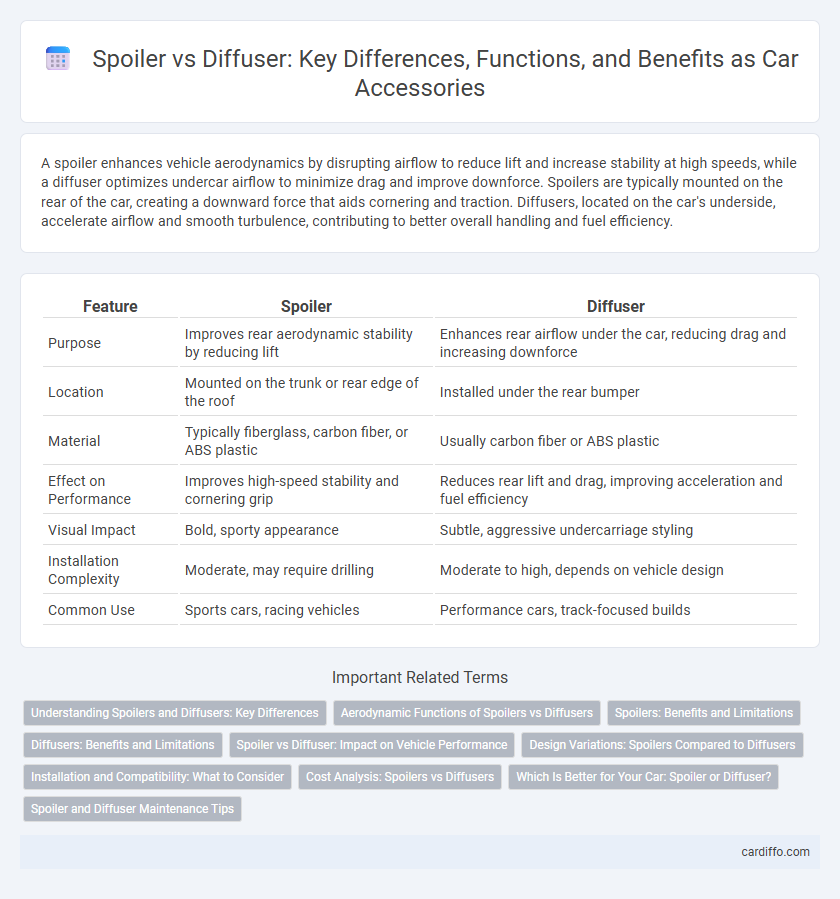A spoiler enhances vehicle aerodynamics by disrupting airflow to reduce lift and increase stability at high speeds, while a diffuser optimizes undercar airflow to minimize drag and improve downforce. Spoilers are typically mounted on the rear of the car, creating a downward force that aids cornering and traction. Diffusers, located on the car's underside, accelerate airflow and smooth turbulence, contributing to better overall handling and fuel efficiency.
Table of Comparison
| Feature | Spoiler | Diffuser |
|---|---|---|
| Purpose | Improves rear aerodynamic stability by reducing lift | Enhances rear airflow under the car, reducing drag and increasing downforce |
| Location | Mounted on the trunk or rear edge of the roof | Installed under the rear bumper |
| Material | Typically fiberglass, carbon fiber, or ABS plastic | Usually carbon fiber or ABS plastic |
| Effect on Performance | Improves high-speed stability and cornering grip | Reduces rear lift and drag, improving acceleration and fuel efficiency |
| Visual Impact | Bold, sporty appearance | Subtle, aggressive undercarriage styling |
| Installation Complexity | Moderate, may require drilling | Moderate to high, depends on vehicle design |
| Common Use | Sports cars, racing vehicles | Performance cars, track-focused builds |
Understanding Spoilers and Diffusers: Key Differences
Spoilers and diffusers are crucial aerodynamic accessories that enhance vehicle performance by manipulating airflow to improve stability and handling. Spoilers primarily disrupt airflow to reduce lift and increase downforce on the rear of the vehicle, boosting traction during high-speed driving. Diffusers accelerate air exiting from under the vehicle, reducing pressure and increasing downforce to enhance grip and reduce drag, making them vital components in performance and racing cars.
Aerodynamic Functions of Spoilers vs Diffusers
Spoilers disrupt airflow to reduce lift and increase vehicle stability by creating downforce, especially at high speeds. Diffusers manage airflow underneath the car, accelerating air exit to reduce pressure and enhance overall downforce without adding drag. Both components optimize aerodynamic performance but target different airflow areas for improved handling and safety.
Spoilers: Benefits and Limitations
Spoilers enhance a vehicle's aerodynamics by disrupting airflow, reducing lift, and improving traction at high speeds, which boosts stability and handling. They also contribute to fuel efficiency by minimizing drag, especially on performance and sports cars. However, spoilers can add weight and may increase drag if improperly designed, limiting their effectiveness in everyday driving conditions.
Diffusers: Benefits and Limitations
Diffusers enhance vehicle aerodynamics by managing airflow underneath the car, reducing drag and increasing downforce for improved stability at high speeds. They contribute to better fuel efficiency and handling performance, especially on sports and performance vehicles. However, diffusers can be costly to install, may not provide significant benefits on everyday cars, and require precise design to avoid disrupting overall vehicle balance.
Spoiler vs Diffuser: Impact on Vehicle Performance
Spoilers improve vehicle performance by increasing downforce, which enhances traction and stability at high speeds, reducing lift and improving cornering ability. Diffusers optimize airflow underneath the vehicle, minimizing drag and increasing aerodynamic efficiency, which can lead to better fuel economy and higher top speeds. Choosing between a spoiler and diffuser depends on whether the priority is improved handling through downforce or enhanced aerodynamic flow for reduced drag.
Design Variations: Spoilers Compared to Diffusers
Spoilers typically feature raised, aerodynamic designs aimed at reducing lift and improving high-speed stability by disrupting airflow over the rear of a vehicle. Diffusers, in contrast, have sculpted underbody shapes that accelerate airflow underneath the car, enhancing downforce and reducing drag without altering the vehicle's silhouette. Design variations highlight spoilers as prominent visual elements, while diffusers integrate seamlessly into the car's rear architecture for subtle aerodynamic benefits.
Installation and Compatibility: What to Consider
When installing a spoiler or diffuser, it is crucial to consider vehicle model compatibility to ensure proper fitment and effectiveness. Spoilers typically require mounting points on the trunk or rear hatch, while diffusers integrate with the undercarriage, necessitating checks for clearance and attachment options. Professional installation is recommended for both accessories to maintain aerodynamic performance and avoid damage.
Cost Analysis: Spoilers vs Diffusers
Spoilers typically cost between $150 and $500, depending on material and brand, while diffusers range from $100 to $400, influenced by design complexity and vehicle compatibility. Installation expenses for spoilers often exceed those for diffusers due to mounting requirements and potential custom fitting. Considering both parts and labor, diffusers generally offer a more budget-friendly aerodynamic enhancement for most vehicles.
Which Is Better for Your Car: Spoiler or Diffuser?
Choosing between a spoiler and a diffuser depends on your car's performance needs and aesthetic preferences. Spoilers improve rear downforce by disrupting airflow over the vehicle, enhancing stability at high speeds, while diffusers optimize underbody airflow to reduce drag and increase overall aerodynamic efficiency. For track-focused cars seeking maximum grip, spoilers offer better stability, whereas diffusers benefit those prioritizing high-speed aerodynamics and fuel efficiency.
Spoiler and Diffuser Maintenance Tips
Regular cleaning of spoilers with mild soap and water prevents dirt buildup and preserves paint quality, while inspecting for cracks or loose fittings ensures aerodynamic efficiency. Diffuser maintenance involves clearing debris from under the vehicle and checking for damage to maintain optimal airflow and vehicle stability. Both accessories benefit from routine inspections to avoid performance degradation and costly repairs.
Spoiler vs diffuser Infographic

 cardiffo.com
cardiffo.com